COMMENTS ON THE ART MARKET
Upcoming Gallery Exhibition
ARC SELECT 2024
Opening April 4th
Rehs Contemporary and The Art Renewal Center proudly present our latest collaboration, showcasing outstanding artists discovered through the esteemed ARC Salon.
The exhibition, curated by Co-Director Lance Rehs, will highlight a group of artists whose works exemplify superior technical skills and classical training, while embracing contemporary themes and styles. Each artist brings a unique perspective and mastery of their craft, creating a diverse and dynamic showcase of artistic talent.
Among the featured artists is Tina Spratt, whose awe-inspiring Elysium will take center stage in the exhibition. Measuring 30 x 36 inches and executed in oil on linen panel, Elysium portrays a woman lying on a bed, her hands running through her auburn brown hair as it cascades towards the ground. Adorned in an intricately embroidered kimono, she exudes an aura of serene beauty. Shana Levenson, another award-winning artist, will present a collection of her iconic mylar balloon paintings featuring high-end fashion designer logos set against a backdrop of vibrant florals. Each piece offers a whimsical commentary on consumer culture and luxury brands. Margo Selski, known for her fantastical approach to painting, draws inspiration from the world of Alice in Wonderland. Her surreal scenes invite viewers on a journey through a dreamlike landscape filled with wonder and intrigue.
The exhibition will also feature paintings by Allen Douglas, Greg Hildebrandt, Christine Porter Lofaro, and Mike Wimmer, as well as sculptures by Dan Chudzinski. Each artist brings a unique set of skills and artistic vision to the mix, creating a dynamic and thought-provoking experience.
"We are thrilled to present this exceptional group of artists whose works exemplify the highest standards of artistic excellence," said co-director Alyssa Rehs. "From traditional techniques to innovative approaches, each artist offers a fresh perspective that is sure to enthrall visitors.”
All works featured in the exhibition will be available for sale, providing attendees with the opportunity to acquire pieces from some of the most talented artists working today.
Join us on April 4th from 5 – 8 pm for the evening opening; the exhibition will continue through May 3rd.
Upcoming Fair
The Philadelphia Show
There are only a few weeks until the start of The Philadelphia Show. The exhibition takes place on the East Terrace of the Philadelphia Museum of Art. We will be exhibiting a wide range of historical works including works by Berthelsen, Blanchard, Bonheur, Buffet, Buttersworth, Cariot, Cortes, Ellenshaw, Ridgway Knight, Koekkoek, along with a curated group of contemporary works by Bauer, Bolcato, Watanabe, Stobart and others.
Preview Party:
Thursday, April 25th
General Show Hours:
Friday, April 26: 11 am - 7 pm
Saturday, April 27: 11 am - 6 pm
Sunday, April 28: 11 am - 5 pm
We now have our allotment of Complimentary Tickets.
If you would like to attend, please send us an email (info@rehs.com) and include your mailing address.
____________________
Stocks & Crypto
Thursday was the final trading day of March, marking the close of 1Q of 2024. By the numbers, things keep getting better, yet at the same time, I can’t help but point out how it just doesn’t feel that way… I mean, all is well here at the gallery, but does anyone else think something feels a bit off? I can’t exactly explain it, but while stock markets are closing at record highs, people seem discontent – maybe money really can’t buy happiness.
Anyway… for the month, the Dow was up 2.1%, the Nasdaq was up 2.7%, while the S&P notched a 3.6% gain. As for the quarter, those figures are a bit more eye-popping – 5.6%, 9.1%, and 10.2%, respectively… all three indexes have set fresh all-time records; in fact, the Nikkei and FTSE are also at record levels. On top of that, the S&P had its best start in 5 years, going back before the pandemic; the Dow, unbelievably, is inching its way toward the 40,000 threshold. Again, I can’t explain it… did someone say soft landing? It’s worth consistently reiterating how complex this whole situation is… I mean, at the same time, we have data coming out detailing how delinquency rates increased on all types of consumer debt, from credit card debt to auto loans to mortgages. So, we’re borrowing more, spending more, not paying it back, and saying this is better? Like, what?
Moving on to currencies and commodities… both the Pound and Euro saw slight fluctuations but remained relatively stable in relation to the US dollar throughout March. Oil futures are up nearly 6%, while gold prices have popped more than 9%, the latter resulting in an all-time high of $2,250.
Last but not least are the crypto kids, though Bitcoin is starting to feel a bit more like an adult at this point; it crossed the $70K mark this month! While it has retreated a bit, it still sits at a lofty $69.5K, which is roughly a 13.5% gain for March… it’s up a staggering 65% from the start of the year. Ethereum turned in a modest gain of just 4.4% for March, though at one point, it was up more than 20%... still, it has gained more than 53% in 2024. Litecoin has seen a nice run with a 32.5% jump this month but still lags behind the others for the year with just a 45.5% return. Oh, and a delightful surprise: the runt of the litter is back in action… Dogecoin rocketed 118% this month!
So, what does it all mean? If I haven’t made it abundantly clear yet, I have no idea… my best guess is it’s all a bit bubbly, but I’ll always take the gains over losses.
____________________
Really!?
Titanic Movie Prop Stays Afloat

Door frame
On March 24th, Heritage hosted the Treasures from Planet Hollywood sale, featuring approximately 1,600 pieces of Hollywood memorabilia. Some of the most popular lots were iconic movie props such as blasters from Star Wars, an axe from The Shining, and Forrest Gump's box of chocolates autographed by Tom Hanks. All in all, the collection fetched an outstanding $15.68 million ($22.8 million with premiums) in sales.
Several items up for grabs came from James Cameron's monumental 1997 film Titanic. Many of the props featured at Heritage were simple items like plates and silverware, pieces of luggage, and lifeboat oars. However, there were also a few pieces that were more recognizable and far more controversial among film buffs. In the movie, one of the most famous (or infamous) scenes involves Rose, played by Kate Winslet, holding onto a door to stay afloat after the titular ship sinks beneath the freezing waves of the North Atlantic. This scene has sparked much discussion and debate over the years, particularly about whether or not there was enough room on the door for both Rose and Leonardo DiCaprio's character, Jack. The ornate Louis XV-style movie prop, adorned with floral accents and elegant curves, has been revealed to be "part of the door frame just above the [ship's] first-class lounge entrance." The fragment sold for an astounding $575K ($718,750 w/p).
Additional notable Titanic-related items included:
- Rose's exquisite white chiffon dress that sold for $95K ($118,750 w/p).
- The wheel from the ship's helm selling for $160K ($200,000 w/p).
- The brass engine order telegraph garnered $65K ($81,250 w/p).
Standout items from other films include Harrison Ford's whip from Indiana Jones and the Temple of Doom, which fetched a record-breaking $430K ($525K w/p); Bill Murray's iconic red-rose bowling ball from Kingpin, selling for an impressive $280K ($350K w/p); and the Barbasol can used by Wayne Knight to steal dinosaur embryos in Jurassic Park, which sold for $250K ($312.5K w/p). Bidding wars erupted over many pieces, underscoring the enduring fascination with props, costumes, and other movie memorabilia.
____________________
The Dark Side
Still Missing: The New Year’s Eve Heist

View of Auvers-sur-Oise by Paul Cézanne
This is now the third entry in my ongoing series, which I call Still Missing, where I discuss some of the most interesting unsolved art thefts. While the 1934 Just Judges theft was certainly interesting to look into, here’s something a little more recent: the heist that took place on New Year’s Eve at an Oxford University museum.
The Ashmolean Museum is Britain’s oldest museum. It has been open for over 340 years, often welcoming close to a million visitors annually. At the dawn of the new millennium, it was the scene of a daring robbery. At midnight on New Year’s Eve 1999, an unknown thief entered the museum using the nearby fireworks display as cover. Like the Skylight Caper perpetrators, they gained access to the roof. They entered through a skylight, descended into the galleries, and used a smoke bomb to obscure themself from the CCTV cameras while making their way to View of Auvers-sur-Oise by Paul Cézanne. The painting was created around 1880, showing the northern French town where Cézanne lived at the time. The perpetrator pulled a scalpel from a bag and cut the painting out of its frame. If that wasn’t enough, he also removed the now empty frame from the wall and smashed it on the floor. They then left the building, disappearing into the crowds outside, who had assembled in the street to view the New Year’s fireworks. The entire job took around 10 minutes.
Seeing the smoke and hearing the museum’s alarm going off, the security guards assumed it was a fire. When police and firefighters arrived, the smoke disappeared, revealing the crime scene. The Cézanne was the only work stolen that night. It had been the only Cézanne kept by the Ashmolean at the time, leading investigators to conclude that the thief had specifically chosen that painting to steal. At the time of the incident, the Ashmolean stated the painting was likely worth around £3 million. Some theorized that recent films like Entrapment and The Thomas Crown Affair may have inspired the theft. Some police officers called the incident “a very clever ploy” and “very professional”.
Authorities were rather confident that the Cézanne would be tracked down soon. Others, like Thames Valley Police spokesman Duncan McGraw, were more ambiguous in their predictions: “It could be tomorrow, or it could be in 20 years.” Police initially believed they had tracked the painting down to a pub in the West Midlands, only to find that it was a copy recently made by the landlord after watching the theft’s news coverage.
Still Missing: Raphael’s Self-Portrait

Portrait of a Young Man
by Raphael
Other than no one knowing where the stolen art is, the previous entries in the Still Missing series all have one thing in common. We don’t know who stole the paintings. This incident, however, is the exception. We know exactly who took Raphael’s Portrait of a Young Man.
For over a century, the painting, widely believed to be a self-portrait, was the property of the Czartoryski family, a noble family from Poland. Prince Adam Jerzy Czartoryski acquired it in the 1790s while traveling in Italy, bringing it back to add to the family collection along with Leonardo da Vinci’s painting Lady with an Ermine. Though Prince Czartoryski briefly served as foreign minister for Czar Alexander I, he later became a prominent figure in the November 1830 Polish uprising against Russian rule. Subsequently, a portion of his family’s art collection was destroyed, but he was able to send most of it to safety in Paris, where it would remain for over forty years. When his son, Prince Władysław, returned to Poland, he brought the collection with him and used it as the basis for a museum in Kraków. Today, the Czartoryski Museum is one of the finest art museums in Poland, having recently undergone renovations completed in 2019. However, when the Nazis invaded the country in 1939, the Czartoryski Museum became one of the prime targets for their plunder.
During the invasion, Władysław’s grandson Augustyn managed to flee 130 miles east of Kraków to his house in Sieniawa. However, the Gestapo caught up with him and confiscated the three paintings he brought with him: the Raphael, the Leonardo, and Rembrandt’s Landscape with the Good Samaritan. Hitler’s governor-general of occupied Poland, Hans Frank, decorated his Kraków office with these three paintings. The last time anyone saw Portrait of a Young Man was at Wawel Castle in January 1945. It was originally thought Frank took the painting with him when he fled Kraków. After the Allies arrested Frank, they recovered Lady with an Ermine and Landscape with the Good Samaritan. However, the Allied Commission for the Retrieval of Works of Art never found the Raphael. Some estimate that, should the portrait be relocated, it would be worth hundreds of millions of dollars.
The Czartoryski family continues to search for the painting. The popular 2014 film The Monuments Men features the painting, showing it being destroyed by German soldiers with flamethrowers. However, the Polish Foreign Ministry insists that the painting survived the war and is simply lost. It is undoubtedly the most important and most valuable work of art lost during the Second World War.
Still Missing: Caravaggio’s Missing Nativity
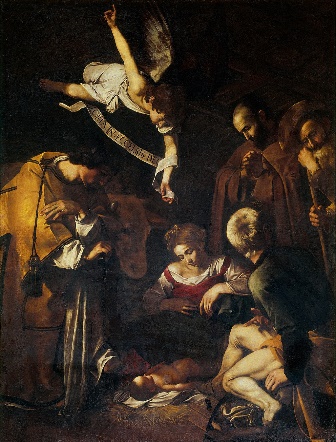
Nativity with St. Francis
& St. Lawrence
by Caravaggio
For the next entry in the Still Missing series, we’ve gone from Canada to Belgium to Britain, and now to Italy. In 2005, the FBI compiled a list of the most significant art thefts on record. One was the theft of a Caravaggio painting from a Sicilian church in 1969.
Nativity with Saint Francis & Saint Lawrence was painted by Michelangelo da Caravaggio in 1609, about a year before his death. It was originally created in Rome but moved to the Oratorio di San Lorenzo in Palermo. The painting shows Mary and Joseph accompanied by, anachronistically, two saints several centuries before their time, all gazing upon the baby Jesus. The figures stand out in front of pitch dark, one of Caravaggio’s hallmarks. Above them, an angel carries a banner reading Gloria in excelsis Deo, or Glory to God in the highest.
On October 17, 1969, two men broke into the church and cut the Caravaggio from its frame. They put it on top of a carpet, rolled them together, and took off. Italian police, the FBI, and Interpol contributed to the initial investigation. In 2009, specialists valued the painting at around $20 million. No one can agree on the painting’s fate. However, it is widely accepted that the Sicilian mafia most likely perpetrated the theft. Several mafiosi who have since become government witnesses stated that they were involved in the initial robbery or saw the painting somewhere following the initial incident. One man told investigators that he had helped steal the work so it could be sold to a private collector. However, when this collector learned they had damaged the Caravaggio by cutting it out of the frame, he became very upset and called off the deal. Other informants say it was gifted or sold to one of several Sicilian mafia bosses, including Gaetano Badalamenti and Salvatore Riina. Some witnesses and investigators claim that the painting was destroyed, while others say it was likely transported to Eastern Europe. There are even some who say that the painting is still hidden somewhere in Sicily.
In 2015, the British broadcasting company Sky commissioned a replica of the Caravaggio, which was unveiled on December 12th of that year. The recently elected president, Sergio Mattarella, was in attendance for the unveiling. His presence there was likely incredibly moving since not only is he a native of Palermo, but his brother Piersanti was an anti-mafia politician who was murdered in 1980, less than two miles away on the other side of the city.
Still Missing: The Secret Tunnel Heist

Tête de Femme
by Adolphe Piot, stolen in 2002
Anyone born in the 1990s probably watched the animated show Avatar: The Last Airbender as it first came out starting in 2005. For this demographic, anything involving tunnels may conjure the “Secret Tunnel song” from season 2, episode 2. This was certainly the only thing I hummed as I read about a little-known heist that rocked South America in July 2002.
At the National Museum of Fine Arts in Asunción, Paraguay, staff walked in one morning to find five empty frames on the wall among their Old Masters collection. The stolen works included a Tintoretto self-portrait, a Madonna and Child by Bartolomé Estéban Murillo, a Gustave Courbet landscape, Tête de Femme by Adolphe Piot, and a painting of Saint Jerome by an unknown artist. The paintings were originally from the collection of Juan Silvano Godoi, the director of the National Library, who founded the museum in 1909.
After securing the building, investigators finally found how the thieves entered the museum. The perpetrators had used pseudonyms to rent a storefront in a building across the street from the museum, saying they wanted to open a health food store. From there, they dug a twenty-five-meter tunnel underneath the street that reached all the way to the offices of the National Archives, which shared the building with the museum. They also dug a third entrance leading to the parking lot of a nearby hotel, where they likely escaped.
In 2002, the estimated value of the stolen paintings was about $200 million. Andrea Machain, writing for BBC Mundo, called it Paraguay’s “robbery of the century,” a title it held until 2017 when a Brazilian gang stole $40 million from a cash storage facility. The museum building at the time had no cameras or night security, meaning that evidence pointing to the thieves’ identity was slim. Investigators initially suspected that the thieves were probably foreign nationals who likely stole the paintings on behalf of a single collector. However, others were skeptical of this theory, saying it was equally as likely that they sold the paintings at auction or on the black market. In Paraguay, many have not forgotten the robbery. Just this past February, Paraguay’s culture ministry sponsored a project hosting five artists at a workshop where they created their reinterpretations of the stolen paintings. These paintings will be exhibited at the National Museum starting March 22nd to commemorate twenty-two years since the robbery.
____________________
The Art Market
Sotheby’s New York “My Friend, Fernando Botero” Sale
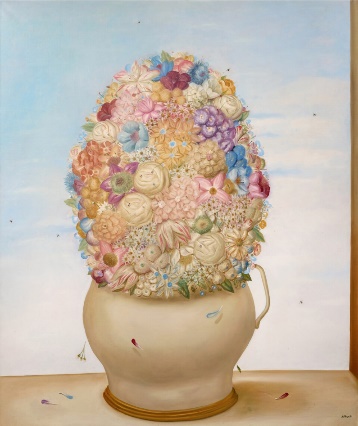
Florero by Fernando Botero
There might be an inverse correlation between the number of lots in a sale and the estimated average value for each painting. And Sotheby’s New York on Friday proved that hypothesis with their very short sale showcasing the Salomón and Rosita Lerner collection. Salomón Lerner founded Librería Lerner, a bookstore that became one of the most significant cultural hubs in Bogotá, Colombia. He and his wife Rosita became close friends with and patrons of the great twentieth-century Colombian master painter Fernando Botero, whose work comprised all but one of the twelve lots featured during the afternoon sale at Sotheby’s. Fernando Botero passed away last September at the age of 91. While he is often remembered as the guy who painted fat people, there is so much more to his work than meets the eye. Botero sought to explore the “sensuality of form” by exaggerating the size and shape of living beings and inanimate objects. He applied this technique to portraits of prominent figures like politicians to satirize them. He also extended this to scenes of Colombian domestic life, still lifes, and landscapes. However, one of the unifying themes of Lerner’s collection of Botero’s work is how the Old Masters frequently influenced his work.
The sale’s top lot was a painting from 1974 known as Florero, or Vase. Sotheby’s specialists described the work as “a triumph of the volumetric distortion and precise execution that defines Boterismo.” Works by the Old Master artists exerted an incredible amount of influence on Botero during his artistic studies. This influence manifests itself here in the form of a floral still-life painting. Florero no doubt draws upon the tradition of flower paintings that reached its peak among Dutch painters during the seventeenth century. The canvas is absolutely massive, measuring 89 by 75 1⁄4 inches, adding another dimension to the artist’s exaggeration of size. Florero was estimated to sell for anywhere between $1 million and $1.5 million, with the hammer coming down at $2.2 million (or $2.72 million w/p).
Moving on from still-life, next was a domestic scene called Jugando a las cartas, or Playing Cards. Again, Sotheby’s specialists drew links back to Old Master paintings and even works by the nineteenth-century modernists. Groups of people playing cards have been a popular subject in Western art for centuries, with the cheaters seen in works by Caravaggio. Furthermore, the small figure in the servant’s outfit with a tray of drinks evokes Velazquez’s portraits, including the Spanish court dwarves. The small servant, as well as the door with the key and its lock, suggests that this is taking place in some private room, part of a larger casino or restaurant. Sotheby’s specialists predicted Jugando a las cartas to sell for between $1 million and $1.5 million, selling for slightly above estimate at $1.85 million (or $2.3 million w/p).
Lastly, in third place was Botero’s 1974 painting La coleccionista. Again, following the recurring theme of Old Master influence, Botero draws upon a common painting genre between the seventeenth and nineteenth centuries. These paintings show the interior of a museum, private collection, or artist’s workshop, with paintings decorating the walls. In Botero’s rendition, we see a conservatively dressed woman standing before a wall of paintings, likewise in Botero’s style. These paintings range from still life to landscapes to portraits and others. La coleccionista hit the high end of its estimate range, selling for $600K (or $762,000 w/p).
There weren’t many surprises during the sale since only twelve lots were available. The only lot that qualifies was Botero’s En la arena, a 1986 painting of a trio of matadors mingling with each other before or after a bullfight. Botero was sent by his uncle to a bullfighting school at the age of twelve, making him very familiar with the manners and lives of matadors. Sotheby’s specialists gave the painting a relatively low estimate, expecting it to sell for no more than $200K. However, it ended up selling for more than double at $420K (or $533.4K w/p). Of the twelve available lots, three sold within their estimate ranges, giving Sotheby’s specialists an accuracy rate of 27%. Most of the lots, seven in total (64%), sold above estimate. Meanwhile, the only painting not by Botero, a still-life by the Chilean hyperrealist painter Claudio Bravo, is the only lot that was bought in. The entire sale was predicted to bring in no more than $6.11 million. Since close to two-thirds of the lots sold above estimate, the sale surpassed this number. The final total eventually came to $7.27 million (or $9.1 million w/p).
Recent Sotheby’s Sale Draws Unwarranted Pessimism
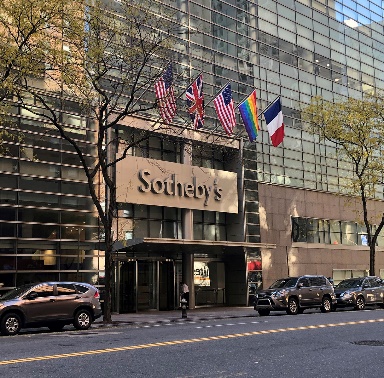
Sotheby's
I wasn’t originally going to write about the Modern & Contemporary evening sale held at Sotheby’s on Wednesday, March 6th. However, I felt compelled to do so after seeing an incredibly misleading headline from The Art Newspaper. According to their analysis, this sale made 40% less than the same sale held last year on March 1, 2023. This number implies that 40% less somehow equates to 40% worse. After reading the piece, I saw they were doing it all wrong.
Kabir Jhala, the publication’s deputy art market editor, described the auction as “staid though not disastrous”. With some of the absolutely enormous sales over the past several years, I suppose Jhala’s expectations are so high that a successful sale by normal standards just won’t cut it. He arrived at that 40% figure by comparing the total hammer prices of this sale and the same sale last year. The 2023 sale made around £137 million (or $164.6 million), while this year’s made about £82 million (or $104.7 million). Therefore, Sotheby’s is doing terribly, the art market is failing, the sky is falling, and so on. This is not just a misleading headline but also an incredibly inaccurate analysis. Yes, the auction house and the name of the sales are the same, but not their contents. The 40% number would be more reflective of the market if it were the same batch of paintings up for sale again. Unfortunately for Jhala, it was a new set of lots up for grabs on Wednesday night. The estimates were, therefore, completely different. So, I would like to set the record straight by pointing out how to better compare these two sales.
To judge whether the Modern & Contemporary sales at Sotheby’s did better or worse this year, looking at a broader array of data is essential. In that regard, the 2024 sale fared better in many ways. It made £82.2 million against the low total estimate of £73.34 million. This is nearly 10% above the low estimate. In contrast, the 2023 sale made £137.2 million against an estimate of £133.6 million, meaning it only did 2% better. Then there is specialist accuracy: on Wednesday night, twenty-seven of the fifty-nine available lots sold within their estimates, giving Sotheby’s specialists a 46% accuracy rate. Meanwhile, the experts had a 40% accuracy rate last year. Both are phenomenal outcomes, but one is clearly better than the other. Furthermore, the 2024 sale did better than last year regarding the sell-through rate. The sale on Wednesday night saw six lots (10%) fail to sell. This is the same number of lots as last year. However, because last year’s sale had fewer lots in total, the unsold lots constituted about 17% of the auction’s contents. Jhala called this year’s 90% sell-through rate “respectable” but also mentioned that this number would fall to 77% if you count all the lots that were withdrawn before the sale. At this point, I think he’s actively trying to be pessimistic about this since you rarely consider the withdrawn works in a sale.
In the end, I think this all comes down to the fact that bad news gets more attention than good news. It’s in the same vein as the old saying in journalism, “If it bleeds, it leads.” If you write about how everything’s fine, people tend to be very blasé about it. But when you frame something as if the world is coming to an end, your readership will listen to what you write. It’s very difficult to compare two sales and say that one objectively did better than the other. You can judge how well the house specialists understand the market by comparing how many lots sold within their estimates. You can also look at individual paintings and highlight if they did better or worse than the last time they were at auction. But every sale is a completely unique event. You can’t boil them down to a single percentage.
Christie’s London Art of the Surreal Sale
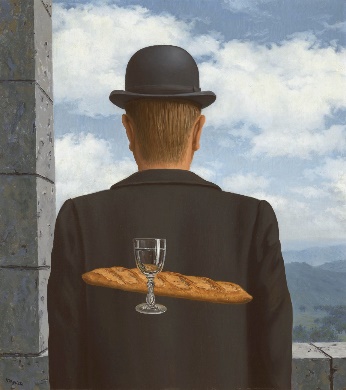
L’ami intime by René Magritte
On Thursday, March 7, Christie’s hosted their annual Art of the Surreal sale. These sales are often relatively short and tend to do rather well. And this year was no exception. The expected star of the sale was the 1958 painting L’ami intime by the Belgian surrealist master René Magritte. Seven of the twenty-five available lots, including the three most valuable, were by Magritte, making him by far the most represented artist in the sale. The painting was previously in the collection of Gilbert and Lena Kaplan and had not been at auction since 1980 when it sold at Sotheby’s London for £90K. Christie’s generated a good amount of attention when they announced that this Magritte would be crossing the block soon. Magritte has become one of the most popular twentieth-century artists on the secondary market, by far the most popular surrealist painter, beating out even Salvador Dalí. But while Magritte’s top paintings sold at auction in the past ten years have normally been from his L’empire des lumières series, L’ami intime features a far more well-known image closely associated with the artist: the man in the bowler hat. Magritte first featured this figure back in 1926 but gained the most recognition from the 1964 painting The Son of Man. Accordingly, Christie‘s specialists assigned L’ami intime an estimate range of £30 million to £50 million. Several people even predicted that it would surpass the hammer prices of some of the L’empire des lumières paintings and set Magritte’s auction record. However, the painting fell slightly short of these expectations, hammering at £29 million / $37.1 million (or £33.66M / $43.1M w/p). While it perhaps didn’t do as well as some had hoped, it still became the second most valuable painting by Magritte ever sold at auction, beating out the L’empire des lumières painting sold for $36.5 million as part of the Mo Ostin collection at Sotheby’s New York in May 2023.
L’ami intime stood head and shoulders above all the other lots, but that was not all the Art of the Surreal had to offer. Magritte dominated the top lots, with second place belonging to La magie noire. A nude woman holds a white rose, standing very statuesquely. The black magic indicated in the title is how, from the head down, she slowly turns into part of the sky as seen behind her. When he painted this picture in 1946, he had been working on this particular theme for over a decade, starting with a similar painting from 1934. Some consider these paintings groundbreaking, as Magritte had brought surrealism to the long-established classical-style nude. This iteration of La magie noire last sold at Christie’s London in 2017 for £1.35M hammer (£1.625 million / $2.02 million w/p). This time around, it sold within its £3 million to £5 million estimate, hammering at £3.8 million / $4.86 million (or £4.64 million / $5.94 million w/p).
Immediately following L’ami intime was another man in a hat, this one entitled Le paysage de Baucis. It shows Magritte’s version of an invisible man, with just eyes, lips, and a nose floating between a fedora and an empty brown suit. The work’s title, however, implies something far deeper. Baucis is a figure from The Metamorphoses by Ovid who, with her husband Philemon, provided shelter and food to Zeus and Hermes traveling in disguise. In return, the gods destroyed their village and killed their ungrateful neighbors, sparing them and turning their hovel into a beautiful temple. According to Christie’s specialists, “The notions of disguise, perception, revelation and of the destruction of the landscape all invoked in this tale, can be seen to chime with the strange, partial apparition depicted in Le paysage de Baucis.” Christie’s predicted this unusual portrait would sell for between £2.4 million and £3 million. Partially making up for where L’ami intime fell short, Le paysage de Baucis sold for £3.2 million / $4.1 million (or £3.9 million / $5 million w/p).
Four of the twenty-five available lots sold for more than double their high estimates, including the single lots by two female artists represented in the sale: Meret Oppenheim and Hannah Höch. Furthermore, both lots by the Romanian surrealist painter Victor Brauner also greatly exceeded their high estimates, with the final lot of the sale, Chasse à l’âme, selling for £170K / $217.7K (or £214.2K / $274.3K w/p) against an initial high estimate of £70K. These surprises were part of the nine lots that sold for over their estimates, making up 36% of the sale. Ten lots sold within their estimates, giving Christie’s specialists a 40% accuracy rate. Three lots (12%) sold for under their estimates, while another three went unsold. In total, the sale brought in £49.5 million / $63.39 million, just squeaking by its minimum presale estimate of £48,020,000. Compared to last year’s Art of the Surreal sale, it appears the market for these kinds of paintings is holding up rather well. Last year, Christie’s specialists had a 44% accuracy rate, with Magritte paintings again reaching the top. It indicates a strong, continuing demand for works not only by Magritte but also by Joan Miró, Remedios Varo, Max Ernst, and Yves Tanguy.
____________________
Deeper Thoughts
Art Show at Mussolini’s House
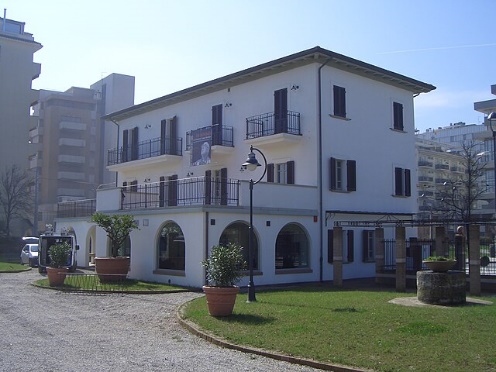
The Villa Mussolini, Riccione
A photography exhibition in northern Italy is drawing criticism over the location where it is being staged.
Riccione, a seaside town right outside Rimini, is hosting a retrospective on Robert Capa, one of the most significant photographers of the twentieth century. Featured, are over a hundred photographs between 1936 and his death in 1954. Capa, born Endre Ernő Friedmann, was on the run for much of his early life. He was born in Budapest, but had to flee Hungary at the age of 18 when accusations of being a communist sympathizer emerged. After spending a few years in Berlin, Friedmann had to escape to Paris when the Nazis came to power since he was Jewish. In Paris, he met a German Jewish photojournalist named Gerta Pohorylla. Together, they published photographs under the name Capa. However, when Pohorylla began working under the name Gerda Taro, Friedmann took the Capa name for himself. Capa soon became a renowned war photographer, documenting multiple conflicts, including the Spanish Civil War, the Second World War, and the First Indochina War. However, he also captured moments from the daily lives of the twentieth century’s most iconic figures, including Pablo Picasso and Françoise Gilot, Gary Cooper, Ingrid Bergman and Alfred Hitchcock, and Henri Matisse. He even became close personal friends with Ernest Hemingway and John Steinbeck.
The controversy surrounding the current Capa retrospective predates the exhibition since it’s more about its location rather than the contents. Riccione chose to host the exhibition at the Villa Mussolini. The three-story building was, evidently, Benito Mussolini’s summer residence, purchased by his wife Rachele in 1934. However, no one ever called it the Villa Mussolini while the fascist dictator resided there. If it had a name at all, it was the Villa Margherita or the Villa Monti. At this location, Il Duce hosted guests and conducted government business for a decade. Because the villa was in Rachele’s name, it was not confiscated by the state after the war, allowing her to sell the property in 1952. In its post-war life, it was the site of a restaurant and then a veterinarian’s office, but it had been abandoned by the 1980s. In 1997, a local bank bought the building and loaned it to the town of Riccione. After a €1 million restoration, the building reopened in 2005 as the Villa Mussolini; a cultural events space. The name drew negative attention then, especially since the dictator’s youngest child, Romano Mussolini, attended the reopening.
The Robert Capa retrospective is just the latest instance of attention drawn to the building’s name. Many have noted that it seems inappropriate for the Villa Mussolini to host the work of a Jewish photographer, especially one who had to flee Berlin out of fear of fascist persecution. On the other hand, it also seems like an ironic act of justice. What better way to spite fascists than to use Mussolini’s villa to exhibit the work of a Jewish artist? And not just any Jewish artist; one who documented the struggle of antifascist Republicans during the Spanish Civil War, and who accompanied American soldiers sent to liberate France from fascist occupation. Giving the site this name so many decades removed from the trauma of the Second World War may have been a little insensitive. But perhaps there is a sort of poetic justice in displaying Capa’s photographs there. It could be likened to how the Allies chose Nuremberg, a city of such significance to the Nazis, as the place to host the trials of fascist war criminals. Il Duce likely would have hated it, and that’s more than enough for me.
British Mural Recreates 100-Year-Old Photo

View of Cowgate, 1908
Some see graffiti and street art as signs of community degradation. However, one place in Britain views it the opposite way. The city of Peterborough, in the east of England, is embarking on a “business improvement district campaign,” which includes a mural on the side of a barbershop offering a brief glimpse into what the city looked like over a century ago.
Nathan Murdoch and Tony Nero are local artists commissioned by the Peterborough Positive campaign to create a street scene mural based on a 1908 photograph. The original picture that Peterborough Positive CEO Pep Cipriano first saw on a postcard shows a view of Cowgate, one of the city’s old streets about a five-minute walk from Peterborough Cathedral. Cowgate was one of the city’s main roads for centuries, frequently used to get to and from the cathedral, guildhall, and marketplaces. At the time of the photo, Peterborough was a relatively small city of just over 30,000 inhabitants, or about seven times smaller than today. The main industry in the area was brickmaking.
Murdoch and Nero are recreating this black-and-white photograph on the wall of a barbershop called Head2Head, which sits at the entrance of Cowgate, right off the Queensgate Roundabout. Cipriano states, “The mural will not only pay tribute to our past but will also be an eye-catching and detailed piece of art that adds to the visual appeal of Cowgate.” Although this is a commission from the city, Cipriano insisted that no taxpayer money is being spent on the project. The initiative’s central focus is ‘placemaking.’ With Peterborough Positive, the mission is to create “a more attractive, appealing and sustainable city centre”.
Murdoch has some experience in this sort of work. For the past few years, he has been creating murals and other forms of street art for various organizations, including Arts Council England, the Young People’s Counselling Service, and the local charity Diaspora. Murdoch was originally the only artist commissioned to create the Cowgate mural, mainly because he is primarily known as a graffiti artist. Murdoch brought in Nero, who worked as a graphic artist before switching to paintings and charcoal drawings, to help deal with the mural’s finer details. The Cowgate mural achieves several goals including enriching the area with a new piece of public art while simultaneously harkening back to its past.
“Slasher Mary”: Museum Protest Then & Now
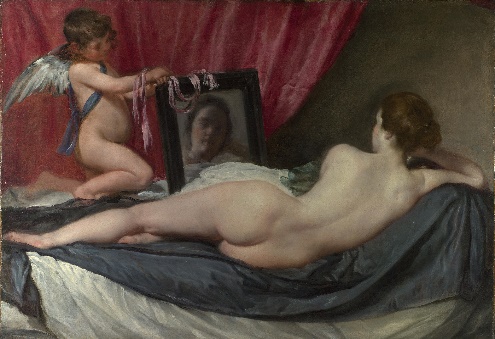
The Rokeby Venus by Diego Velázquez
With the dozens of climate protests at museums over the past several years, many are inclined to see activists’ vandalism of prominent artworks as a fairly modern concept. Last month, someone threw soup at a Monet while others taped photos over the protective glass on Botticelli’s Birth of Venus. However, many would probably be surprised to learn that today marks the hundredth anniversary of one of the most famous examples of such protest. Even when mass media was in its infancy, some people already understood how to use it, including an activist in Britain named Mary Richardson.
On March 10, 1914, Richardson walked into London’s National Gallery. On display that day was a painting by Diego Velázquez popularly known as the Rokeby Venus. It is the only female nude Velázquez created that still survives today. When Richardson got close, she pulled out a meat cleaver and repeatedly began hacking, creating a series of large slashes across the canvas. In a prewritten statement published in The Times the following day, Richardson confessed that her actions were in support of the Women’s Social and Political Union (WSPU), the leading women’s suffrage organization in Britain. The fight for women’s suffrage in Britain was far more turbulent than in the United States. American women’s organizations prioritized respectability, while British suffragettes increasingly took part in direct action. When suffragettes were imprisoned for their protests, they often went on hunger strikes, leading to them being forced fed, a method now considered a form of torture by some medical bodies. By 1912, suffragettes began to protest more severely, initiating a campaign of bombings across the country; targeting government buildings, churches, and even private homes. They started by bombing the homes of three cabinet ministers as well as the Home Secretary’s office. They also tried to set fire to the Theatre Royal in Dublin during a matinée performance while Prime Minister H.H. Asquith was in attendance.
Richardson’s stunt caused the Royal Academy and the Tate Gallery to close temporarily. Women were not allowed to enter the British Museum unless a man accompanied them. Despite increased security, four months after the initial incident, another suffragette named Anne Hunt entered the National Portrait Gallery and used a cleaver to deface John Everett Millais’s portrait of Thomas Carlyle.
While Richardson damaged the Velázquez to draw attention to the women’s suffrage movement in general, the act was likely provoked by the recent arrest of WSPU founder Emmeline Pankhurst the day before. Richardson wrote, “I have tried to destroy the picture of the most beautiful woman in mythological history as a protest against the Government for destroying Mrs. Pankhurst, who is the most beautiful character in modern history.” Richardson was branded in the newspapers as “Slasher Mary”. Activists in Britain seem to remember the Rokeby Venus as a symbol of protest. Just this past November, as Mary Richardson had done, climate protestors entered the National Gallery and used hammers to smash the layer of protective glass covering the Rokeby Venus. Just Stop Oil, the organization responsible for many of these recent incidents, wrote in a statement, “Politics is failing us. It failed women in 1914, and it is failing us now.” Writing for Forbes, Alexandra Bregman astutely observed the connection between today’s climate activists and the suffragettes of a century ago. She also offered a degree of uncertainty about the effectiveness of these tactics: “Whether the splashers of today will implement the same progress as the slashers of yesterday remains to be seen, but their place in history will never be forgotten.”
Ukraine’s New Museum

Ukraine
Using museums to shape the public’s perception of the past and the present is far from a new idea. This is especially true when it comes to governments with authoritarian streaks. And we are seeing it again with Russia concerning their current military endeavors in Ukraine. Everyone involved in the ongoing conflict understands that art and culture play an important role in the war’s trajectory and the world’s perception of it. Now, Russia’s government is trying to use museums to push its narrative of the conflict.
Over the past two years, Russia’s armed forces have been responsible for the destruction and appropriation of Ukraine’s culture and national heritage. Cultural organizations have spread themselves thin trying to protect Ukrainian works of art, going as far as to smuggle truckloads of works out of the country for safekeeping in Western Europe, ranging from ancient artifacts to paintings by contemporary artists. Many Ukrainian museums in Russian-held territory now have new staff. These museums are now being repurposed to suit Russia’s needs, including a new museum in Mariupol.
When Russia invaded Ukraine in February 2022, the city of Mariupol came under siege. For nearly three months, the Ukrainian defenders kept the Russians at bay. About 90% of the city was destroyed in the process, while two-thirds of the population fled the area. Many of the city’s museums and galleries were damaged or completely destroyed. Even though the loss of the city to Russia was one of the major early defeats for Ukraine, the amount of time and effort it took for Russia to take the city and the subsequent humanitarian disaster cost Russia dearly on the world stage. However, Russia’s government intends to view Mariupol’s capture not as an invasion but as a liberation, which is the focus of the new museum in Mariupol. According to Russia’s culture minister Olga Lyubimova, the museum will be dedicated to “the modern history of Donbass and Novorossiya”. ‘Novorossiya’ literally means ‘New Russia’, and is a czarist term for southern Ukraine that has been dusted off and used by Putin and pro-Russia groups to refer to Russian-occupied territories in Ukraine.
This new museum in Mariupol is just one of several museums the Russian government is establishing. A document drafted by Russia’s culture ministry specifies what these museums should have on display, including children’s toys stained with blood, ammunition provided by NATO, and knives decorated with swastikas and other Nazi symbols. This last addition serves as a reminder of the Kremlin’s absurd claims that Ukraine’s government constitutes a neo-Nazi state committing genocide of Russian-speaking people in the country.
Russian authorities plan on opening the “liberation” museum this summer… that is unless they lose the city to Ukrainian forces before then.
Gilot at the Picasso Museum

Françoise Gilot
and Pablo Picasso, 1952
It is often said that seven women played significant roles throughout Pablo Picasso’s life. Probably one of the most well-known was Françoise Gilot. Last week, Paris’s Picasso Museum opened with a brand new rehang, with one of the galleries entirely dedicated to her work. This is even though the institution’s namesake tried to destroy her life and career.
Gilot met Picasso in 1943 when she was 21 years old. He was 61 years old and had an incredibly chaotic love life. At the time, he was in a relationship with the French photographer Dora Maar while still married to his wife, the Russian dancer Olga Khokhlova. Maar had actually been his second mistress. His first was a young French girl named Marie-Thérèse Walter, who became his muse and inspired many of his abstract approaches to painting the female form in the 1920s and 1930s. Picasso was, in fact, rather open about his extramarital affair with Walter. His first retrospective at the Galerie Georges Petit in Paris in 1932 featured several nude portraits of Walter, including Le Rêve, which would become one of the most valuable paintings in the world when Steve Wynn sold it in 2013 for $155 million.
Despite Françoise Gilot being a figure in the arts for eight decades, many familiar with her name only know of her in relation to Picasso; as his partner and the mother of two of his children. Gilot and Picasso were together for ten years, from 1943 to 1953. In the cases of his previous mistresses like Marie-Thérèse Walter and Dora Maar, Picasso would first meet them when they were teenagers, draw inspiration from them, use and abuse them, and then move on to the next woman when she happened to come along.; not exactly surprising behavior from a man who described all women as “machines for suffering”. But it was actually Gilot who left Picasso rather than the other way around. Subsequently, Picasso’s rage fully manifested itself. While he had physically and emotionally abused Gilot throughout their relationship, he went above and beyond after Gilot broke things off. Picasso made a concerted effort to sabotage Gilot’s artistic career. He reached into his network of galleries and dealers, insisting that none of them buy, sell, or exhibit Gilot’s work. She had to leave Europe for the United States to escape Picasso’s influence. According to the Picasso Museum’s painting curator Joanne Snrech, Picasso’s actions are why Gilot has “a very limited presence in French public collections”.
However, the Picasso Museum now wishes to move towards rectifying the damage done in this small way. The works featured in the Picasso Museum’s Gilot gallery are all on loan from other institutions and private collections. These works will only be on display for one year before the museum curators rehang the room again. In the exhibition, they wish to treat Gilot not as Picasso’s mistress but as a great artist in her own right who just happened to have a relationship with Picasso. Her recognition has gained traction in recent years, accelerating especially rapidly following her death in June 2023 at the age of 101. Gilot has always had greater recognition in the United States than in Europe, so this exhibition being staged in Paris is a sign of changing attitudes towards her work and legacy. She should be remembered for the eighty years of work she produced rather than the ten turbulent years she had with Picasso.
Gilot at the Picasso Museum

Girl with a Pearl Earring
by Johannes Vermeer
A Dutch court has made an interesting ruling that may set a precedent for how prosecutors deal with climate protesters.
On October 28, 2022, three Belgians staged a protest at the Mauritshuis in The Hague to draw attention to our current climate crisis. To do so, one glued his head to the protective glass layer covering Johannes Vermeer’s Girl with a Pearl Earring. Another glued his hand to the gallery wall while the third filmed the incident. Initially, prosecutors in the Netherlands charged the trio with property damage and public violence, for which they received a two-month prison sentence. However, a Dutch appeals court has recently rescinded this punishment.
Their reasoning comes from two places: first, the three climate demonstrators were aware that the Vermeer had a layer of glass protecting it, so they fully understood that their demonstration would not harm the painting in any way. The only damage was that the glass and the painting’s frame had to be cleaned afterward. Furthermore, the Mauritshuis refunded the tickets of visitors who had come to see the Vermeer but were not able to since it was taken off the gallery wall for cleaning in the incident’s aftermath. Therefore, not only was there not much property damage but there was no intent to do damage on the demonstrators’ part. The court reasoned that, while it discourages people from participating in these protests, imposing a prison sentence would infringe upon the freedom of speech and the right to protest peacefully. The demonstrators had already spent twenty-three days in detention before their initial trial. That, according to the appeals court, was more than enough.
It will be interesting to see how the Dutch government, the Mauritshuis, and the art world will generally react to this news. In a way, the court has recognized that, while many are quick to call these protests “attacks” or “acts of vandalism”, these artworks are seldom damaged. Michael Wang of Art in America noticed this as well, writing, “If these truly were attacks, the injuries sustained by the artworks were ephemeral”, and that they are merely “political performances that operate primarily within the symbolic sphere.” Discussions about these demonstrations have allowed many to enter conversations and debates about climate change. It has increased the general population’s awareness of important issues, which is one of these protestors’ goals.
Trafalgar Square’s New Resident
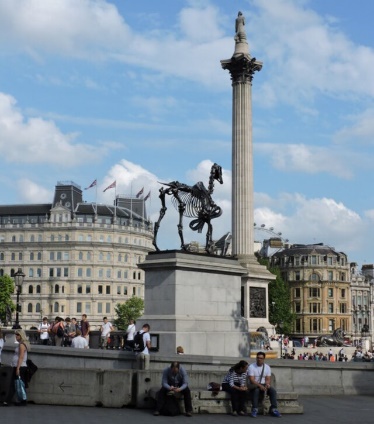
Trafalgar Square’s Fourth Plinth,
at the time occupied by
Hans Haacke’s sculpture
Gift Horse
(photo courtesy of Thomas Nugent)
London’s Trafalgar Square has a plinth at each of its four corners. Three of them have statues, while one has nothing on top of it. It was originally meant to have an equestrian statue of King William IV, but not enough money was raised for the project. For one hundred fifty years, the pedestal remained empty. It wasn’t until 1999 that British arts organizations began to use the empty plinth to exhibit contemporary works of art. Since 2005, the Fourth Plinth Commission has chosen the new works, rotating out every two years. And just this past weekend, the organization announced their two latest pieces meant to mount the plinth in 2026 and 2028.
Since September 2022, the fourth pedestal in Trafalgar Square has been the home of Samson Kambalu’s sculpture Antelope. The work recreates a 1914 photograph of Baptist minister and anti-colonialist activist John Chilembwe with British missionary John Chorley. In September, Antelope will be replaced with Teresa Margolles’s sculpture 850 Improntas, which will take its place in Trafalgar Square from 2024 to 2026. 850 Improntas consists of a series of plaster casts the artist took from the faces of several hundred transgender people. Drawing on her Mexican heritage, Margolles designed 850 Improntas in the style of a tzompantli, a rack indigenous people in Mexico and Central America used to display human skulls. These were often the skulls of human sacrifices, and many archaeological sites in the region show relief sculptures on buildings meant to represent these tzompantli. Before becoming an artist, Margolles was a forensic pathologist and a mortician in Mexico City. She drew from her experiences witnessing the effects of anti-trans violence in her own country to create this poignant memorial for those suffering today.
But now, the Fourth Plinth Commission has chosen what will come after 850 Improntas. In 2026, the fourth plinth will become the home of Lady in Blue by Tschabalala Self. It is a bronze sculpture of a woman in a lapis lazuli dress, representing modern, urban womanhood. Self sought to create something that represented all women, contrasting with the statues of famous men that occupy the other pedestals around Trafalgar Square. According to the artist, “She is not an idol to venerate or a historic figurehead to commemorate. She is a woman striding forward into our collective future with ambition and purpose. She is a Londoner, who represents the city’s spirit.”
The work set to replace Lady in Blue in 2028 is an untitled resin sculpture by Andra Ursuța meant to represent a horse and a rider under a shroud. Horse-themed works have been chosen in the past, which is appropriate given the equestrian statue on the other side of the square. A statement from the Mayor of London’s office asks, “Is it yet to be uncovered? Or is it an already canceled public monument – a ghost of history, a parody of itself?”
Being chosen to appear in Trafalgar Square has become one of the most prestigious opportunities granted to contemporary artists over the last few decades. Previous exhibitors include the sculptor Antony Gormley, whose performance art piece One & Other consisted of one person mounting the pedestal every hour for a hundred days straight. These people were free to do whatever they wanted, from performing science experiments to reading poetry to dressing up like Godzilla and destroying a cardboard replica of London. Some have proposed ideas for permanent statues to occupy the plinth, with subjects ranging from Queen Elizabeth II to Margaret Thatcher to Alan Turing. However, like many, I think accessibility is an important aspect of art. Art events like exhibitions, gallery openings, and biennial shows in Venice can often seem like closed-off spaces. Therefore, bringing art into people’s lives can improve both their lives and the state of art in society. Like Keith Haring’s drawings in the New York subway or any concrete wall in Banksy’s path, Trafalgar Square’s fourth plinth serves that purpose.
The Rehs Family
© Rehs Galleries, Inc., New York – April 2024
